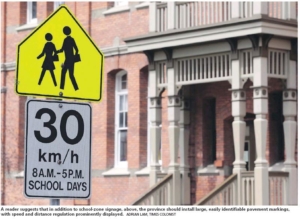Reader Suggestions for Safer School Zones

Gar had a suggestion that would make school zones more identifiable to drivers. He wanted to have large, easily identifiable pavement markings, with speed and distance regulation prominently displayed. This would work well in the Lower Mainland and Island areas, where snow is not a regular winter occurrence.
The many responses to last week’s school and playground column is proof of the confusion surrounding when they apply and the degree of enforcement by police authorities. Rob reminded me that some rural roads have school-zone signs that display a 40 km/h sign tab, with the wording: “When children on highway.” Selective ambiguity and an enforcement nightmare come to mind.
Gord wanted to know why he sees more than one school-zone sign, on the opposite side of the road, facing the other way, signifying the end of the zone. Only the first sign counts for those leaving the zone. The first sign is meant to warn those oncoming drivers having turned into the zone from a side street.
Richard had the best rhetoric of all readers. He thinks the figures on the school-zone signs resemble an elderly lady helping an old man across the street. Some preschool kids think it is people going to the airport carrying luggage, since school-aged kids would have backpacks.
Pat wants rumble strips at the beginning of all school and playground zones. Simple solution?
Connie takes the wacky-schoolzone first prize for her sense of humour. She tells of school zones on Salt Spring Island, in effect on the four-day school week, Monday to Thursday. When Monday is a holiday, school is on Friday! How is a visitor to know? She has trouble remembering Monday, at the beginning of the week, was a holiday. She no longer has kids in school. Therefore, every day seems like a holiday on Salt Spring.
Mark believes the skill and safety of many professional drivers has declined over the past decade. He is probably on to something. At a previous drivingschool convention, we learned that about 30 per cent of big-rig professional drivers had retired in the past 10 years, and a further 30 per cent were due to do the same in the next decade. Despite excellent training programs in most provinces, nothing beats experience. The extremely catastrophic Saskatchewan bus-truck crash involving the Humboldt junior hockey team is a lesson learned at the expense of so many innocent young lives. Mark is likely correct in his assertion.
John wants all cyclists on the Galloping Goose to have a bell or horn. He wants to be warned when they approach from behind. The voice warning — “On the left!” — is not good enough when cyclists are going 30 km/h or more and bearing down on walkers from the rear.
Marilyn thought she had the right-of-way to turn right on a solid red light, after stopping. She was yelled at by an oncoming cyclist turning left into her lane, the far lane, on the advance flashing green arrow. Who had the right-of-way?
Sorry Marilyn, as illogical as it seems, the cyclist is correct. Only right turners must turn into the most immediate lane on a multilane road. Left turners may legally turn into the second lane, in this case, the curb lane. Despite the fact it is a dangerous thing to do in any case, but particularly on a bike, the right turner, on a solid red traffic light, must yield to this unpredictable but legal oncoming move by the cyclist. If both the motor-vehicle driver and the cyclist have a green light, the cyclist must remain in the immediate left lane when making such a simultaneous turn. Do not feel bad, Marilyn, I had this anomaly explained to me a few years ago by a college.
Steve Wallace is the owner of Joan Wallace Driving School on Vancouver Island. He is a former vice-president of the Driving Schools Association of the Americas, a registered B.C. teacher and a University of Manitoba graduate.


